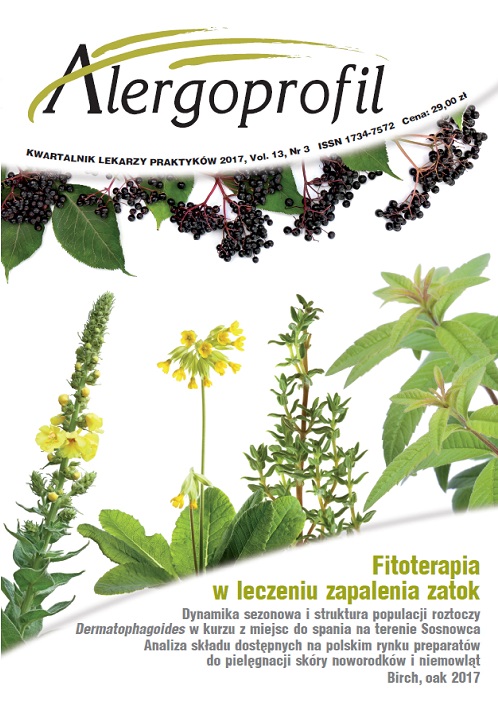Seasonal population dynamics and structure of the Dermatophagoides mites in dust from sleeping accommodations on the territory of Sosnowiec
Main Article Content
Abstract
The typical members of house dust mites are species of the family Pyroglyphidae. The most medically important and most widely distributed species of the family are Dermatophagoides pteronyssinus, Dermatophagoides farinae and Euroglyphus maynei. The aim of the study was to show the temporal changes in abundance and structure of dust mite populations in dwellings throughout the year. A total of 48 dust samples from beds and other sleeping accommodations from 4 flats located on the territory of Sosnowiec were analysed. The examined flats were dominated by mites of the genus Dermatophagoides. Among them D. farinae was predominant. The highest density of D. farinae per gram of dust was observed in autumn, in time when the most favourable conditions of indoor temperature and relative humidity for these mites were noted. Relatively high numbers of nymphs of D. farinae in the examined sleeping accommodations in autumn are indicative of the development of populations during this period.
Downloads
Article Details
Copyright: ? Medical Education sp. z o.o. This is an Open Access article distributed under the terms of the Attribution-NonCommercial 4.0 International (CC BY-NC 4.0). License (https://creativecommons.org/licenses/by-nc/4.0/), allowing third parties to copy and redistribute the material in any medium or format and to remix, transform, and build upon the material, provided the original work is properly cited and states its license.
Address reprint requests to: Medical Education, Marcin Kuźma (marcin.kuzma@mededu.pl)
References
2. Solarz K.: Biologia roztoczy kurzu domowego. Alergoprofil 2008, 4(1): 2-11.
3. Arlian L.G., Woodford P.J., Bernstein I.L., Gallagher J.S.: Seasonal population structure of house dust mites, Dermatophagoides spp. (Acari: Pyroglyphidae). J. Med. Entomol. 1983, 20: 99-102.
4. Baker A.S.: Mites and ticks of domestic animals. An identification guide and information source. The Stationery Office, London 1999: 240.
5. Colloff M.J.: Dust mites. Springer. CSIRO Publishing, Collingwood, Australia 2009.
6. Krantz G.W., Walter D.E.: A manual of acarology. Third edition. Texas Tech University Press, Lubbock, USA 2009: 807.
7. Solarz K.: House Dust Mites and storage Mites (Acari: Oribatida: Astigmatina). Identification Keys. Institute of Systematics and Evolution of Animals, Polish Academy of Sciences, Cracow, Poland 2012: 1-120.
8. Solarz K.: Pyroglyphidae (Acari: Acaridida) in Poland: Distribution, biology, population ecology and epidemiology. Acta Zool. Cracov. 2001, 44: 435-528.
9. Solarz K., Szilman P.: Parazytologia i akaroentomologia lekarska. Podręcznik do ćwiczeń i seminariów. Tom 1. Śląski Uniwersytet Medyczny, Katowice 2011.
10. Chmielewski W.: Dane o występowaniu niektórych gatunków roztoczy alergogennych (Acaroidea) w Polsce. Wiad. Parazytol. 1977, 23: 109-113.
11. Solarz K.: Seasonal dynamics of house dust mite populations in bed/mattress dust from two dwellings in Sosnowiec (Upper Silesia, Poland): an attempt to assess exposure. Ann. Agric. Environ. Med. 1997, 4: 253-261.
12. Kosik-Bogacka D.I., Kalisińska E., Henszel Ł., Kuźna-Grygiel W.: Seasonal dynamics of house dust mites in dust samples collected from sleeping places in North-Western Poland. Zoonoses Public Health 2012, 59: 8-15.
13. Solarz K.: Temporal changes in the composition of house-dust-mite fauna in Poland. Acta Zool. Cracov. 2010, 53B: 39-64.
14. Kasprzyk M., Wilk I., Solarz K. et al.: Biotyczne i abiotyczne czynniki środowiska wewnątrzmieszkalnego wpływające na liczebność roztoczy alergennych w mieszkaniach miejskich województwa śląskiego [Biotic and abiotic indoor environmental factors influencing the allergenic mite numbers in urban dwellings of the Silesian Province]. W: Buczek A., Błaszak C. (red.): Stawonogi: zagrożenie zdrowia człowieka i zwierząt. Koliber, Lublin 2014: 333-348.
15. Solarz K., Pompa O., Asman M., Szilman E.: Ryzyko ekspozycji na roztocze kurzu domowego i inne stawonogi w trzech górnośląskich szpitalach. Alergoprofil 2010, 6(2): 23-31.
16. Solarz K.: Risk of exposure to house dust pyroglyphid mites in Poland. Ann. Agric. Environ. Med. 2001, 8: 11-24.
17. Chang J.C.S., Arlian L.G., Dippold J.S. et al.: Survival of the house dust mite, Dermatophagoides farinae, at high temperatures (40-80?C). Indor. Air 1998, 8: 34-38.
18. Solarz K.: Annual fluctuation in the number of the developmental stages of Dermatophagoides spp. (Astigmata: Pyroglyphidae) in Upper Silesia Region, Poland. Internat. J. Acarol. 2000, 26: 371-377.
19. Dusbábek F.: Population structure and dynamic of house dust mite Dermatophagoides farinae (Acarina: Pyroglyphidae) in Czechoslovakia. Folia Parasitol. 1975, 22: 219-231.
20. Dusbábek F.: Dynamics and structure of mixed population of Dermatophagoides farinae and Dermatophagoides pteronyssinus. Recent Advances in Acarol. 1979, 2: 173-177.
21. Calvo M., Fernández-Caldas E., Arellano P. et al.: Mite allergen exposure, sensitisation and clinical symptoms in Valdivia, Chile. Investig. Allergol. Clin. Immunol. 2005, 15(3): 189-196.
22. Croce M., Costa-Manso E., Baggio D., Croce J.: House dust mites in the city of Lima, Peru. Investig. Allergol. Clin. Immunol. 2000, 10(5): 286-288.
23. Voorhorst R., Spieksma-Boezman M.J.A., Spieksma F.T.M.: Is a mite (Dermatophagoides spp.) the producer of the house ? dust allergen? Allerg. Asthma 1964, 10: 329-334.
24. Błaszak C.: Zoologia. Stawonogi. Szczękoczułkopodobne, skorupiaki. Wydaw. Nauk. PWN, Warszawa 2011.

